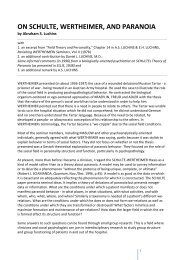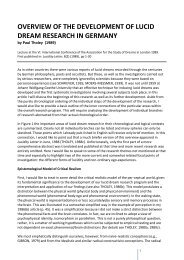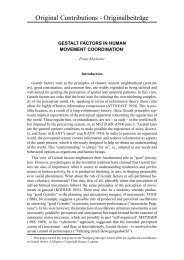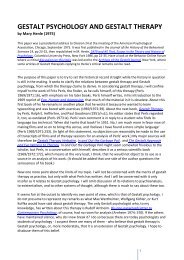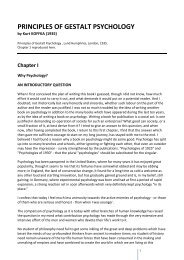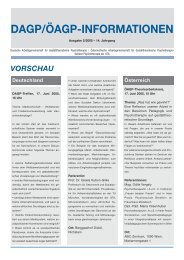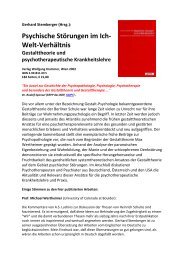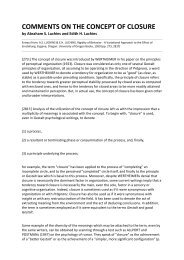The law exemplified in cases of this sort may be called the tendency towards simple <strong>Gestalt</strong>en, or the law ofPrägnanz... This designation comes from WERTHEIMER, not as a description of inorganic physical behaviour, but ofphenomenal <strong>and</strong> there<strong>for</strong>e also of physiological process-structures. Nevertheless it is possible to apply the terms tophysical phenomena also, <strong>for</strong> the general tendency <strong>and</strong> line of development observed by WERTHEIMER in psychology<strong>and</strong> designated by him as the law of Prägnanz is obviously the same as we have here been discussing. (p. 54)It is interesting that the term isomorphism did not occur in the index of KÖHLER s book, <strong>Gestalt</strong>Psychology (1929). Yet it occurred in a few places in the text, <strong>for</strong> example:There is no reason at all why the construction of physiological processes directly underlying experience should beimpossible, if experience allows us the construction of a physical world outside, which is related to it much lessintimately... I should have ever so much difficulty in trying to relate definite experience to definite processes so long asI failed to assume one specific relationship between the two orders, viz., that of congruence or isomorphism in theirsystematic properties. (1929, p. 61)KÖHLER added that the principle was sometimes <strong>for</strong>mulated more explicitly in a number of"psychophysical axioms" (referring in a footnote to George E. MÜLLER, 1897, p. 189). But insteadhe gave examples to illustrate the principle.The term isomorphism occurred frequently in another book by KÖHLER, The Place of Value in aWorld of Facts (1938):... the most essential tra<strong>its</strong> of experimental or perceptual contexts are the same as those of their physicalcounterparts. With respect to these tra<strong>its</strong> the perceptual <strong>and</strong> the physical structures are isomorphic. If they were not,we could have no physics. (p. 162)KÖHLER described many examples <strong>and</strong> concluded:in all these cases it is really structure in which the world of percepts <strong>and</strong> the physical world have so much in common.Resemblance as to the demarcation of definite objects, <strong>and</strong> there<strong>for</strong>e to their number, means in fact similarity in thegross structure of the two worlds. And then inside such particular objects there is again structural resemblancebetween the perceptual <strong>and</strong> the physical world. (p. 166)Physics, it was stated, proceeds on the assumption that certain structural tra<strong>its</strong> of percepts agree with the structure ofcorresponding physical situations. It is, however, only macroscopic structures which can be common characteristics ofthe perceptual <strong>and</strong> the physical world. And this statement has sense only if the notion of macroscopic objects is foundto refer to definite physical entities. We have, I believe, been able to show that it does. It is there<strong>for</strong>e a meaningfulthesis that perceptual <strong>and</strong> physical contexts are isomorphic in essential macroscopic respects, <strong>and</strong> that to this extentthere is resemblance between the phenomenal <strong>and</strong> the physical world, (p. 184)In The Place of Value in a World of Facts (1938), KÖHLER has a chapter (Chapter VI) entitled, "OnIsomorphism," from which we cite:Concerning the emotional sphere, he wrote: "I propose to consider the nature of cortical processes although manyphilosophers dislike to hear much about the brain when philosophical problems are being discussed" (p. 185). "Thecortical correlates of mental life or, as we may also call them, the psychophysical processes, are more interesting <strong>for</strong>our purposes than any other biological facts" (p. 194). "[It is not] a plausible assumption that cortical processes consistof independent events in individual cells. In the following paragraphs psychophysical correlates will, there<strong>for</strong>e, beconsidered from a macroscopic point of view" (p. 212). "Practically any part of human experience might be taken as anexample of the fact that molecular events in the brain do not as such show much resemblance with phenomena" (p.215).Continuity is a structural trait of the visual field. It is also a structural fact that in this field circumscribed particularpercepts are segregated as patches, figures, <strong>and</strong> things. In both characteristics, we have found, the macroscopicaspect of cortical processes resembles visual experience. To this extent, there<strong>for</strong>e, vision <strong>and</strong> <strong>its</strong> cortical correlate areisomorphic. In the last chapter the same term has been used. There, however, it applied to the relation betweenvisual organization on the one h<strong>and</strong> <strong>and</strong> the macroscopic structure of situations in physical space on the other. Thefact which mediates between the physical <strong>and</strong> the perceptual structure is now found to be cortical organization,which, as a rule, resembles both... .Where perceptual organization does not agree with facts in physical space, corticalorganization seems to agree with perception rather than with physics. (1938, pp. 217-218)... .Our present discussion is mainly concerned with the question of isomorphism between the visual field <strong>and</strong> <strong>its</strong>psychophysical correlate... Not <strong>for</strong> a moment should we <strong>for</strong>get, however, that isomorphism, thus considered, is arelation between visual experience <strong>and</strong> dynamic realities. (1938, pp. 218-219)WERTHEIMER: THE PHI PHENOMENON AND ITS SIGNIFICANCE4
The following comes from LUCHINS (1968):WERTHEIMER sought examples from the field of perception, an area of psychology with a highreputation <strong>for</strong> exactness. He had little success until 1910, when he went on a trip, <strong>and</strong> while onthe train, he thought of an optical phenomenon that seemed suitable. At Frankfurt he got off thetrain <strong>and</strong> bought a toy stroboscope. In a hotel room he set up the experiment by substitutingstrips of paper on which he had drawn series of lines <strong>for</strong> the pictures in the toy. The results wereas he expected: by varying the time interval between the exposure of the lines, he found that hecould see one line after another, two lines st<strong>and</strong>ing side by side, or a line moving from oneposition to another. This "movement" came to be known as the phi phenomenon.WERTHEIMER asked SCHUMANN, his <strong>for</strong>mer teacher at Berlin <strong>and</strong> now at the FrankfurtPsychological Institute, if he could provide someone to act as an experimental subject.SCHUMANN s laboratory assistant, Wolfgang KÖHLER came. For the next experimental session,KÖHLER brought his friend Kurt KOFFKA, who also served as a subject. KÖHLER persuadedSCHUMANN to visit WERTHEIMER <strong>and</strong> to invite him to conduct his experiment at the FrankfurtInstitute. A simple apparatus to demonstrate the phi phenomenon was constructed, <strong>and</strong> the nowclassical experiment was conducted (WERTHEIMER, 1912b).WERTHEIMER explained the significance of the experiment as follows: "What do we see when wesee the movements of a h<strong>and</strong> or a light? Is it appropriate to say that we have a sensation indifferent places on the retina from which movement is inferred? Is it appropriate to cut thephenomenon of movement in this way into a number of static sensations?" (1937). Although therehad been psychologists <strong>and</strong> philosophers be<strong>for</strong>e him who believed that movement was not aninference from static sensations on the retina but was a sensation sui generis, they had notdemonstrated this in a scientific manner. WERTHEIMER now presented the thesis in a way whichmade experimental decisions possible.It was not merely WERTHEIMER s experiment but his <strong>for</strong>mulation of the underlying problem <strong>and</strong>the way to proceed to solve this problem that launched <strong>Gestalt</strong> psychology. Through experimentalvariations, he tested, one by one, various possible explanations of the phi phenomenon <strong>and</strong> foundthem wanting. According to WERTHEIMER, the essential features of the phi phenomenon are thefollowing: it is a counter example to the assumption that piecemeal <strong>and</strong> summative approaches topsychological phenomena are universally adequate; it belongs to a category of genuine dynamicexperience which must be understood in terms of dynamics rather than reduced to static events;finally, it is an example of a structure that is not an arbitrary arrangement of events but has innerconnectedness (1937).WERTHEIMER felt that there was a need <strong>for</strong> a model of such dynamic experiences, <strong>and</strong> hehypothesized a possible physiological process: "The motion is due to a field of activity amongcells... not excitation in isolated cells but field effects" (1937). This model applied concepts of fieldtheoreticalphysics to a neurological event. (LUCHINS, 1968, pp. 523-525)WERTHEIMER: ISOMORPHISMThis section is based mainly on LUCHINS <strong>and</strong> LUCHINS (1973, Vol. II, pp. 157-171), whichreconstructed several sessions of WERTHEIMER s 1937-1938 seminar at the New School <strong>for</strong> SocialResearch that were devoted to "a new theory of perception of feelings." First WERTHEIMERdescribed a lecture-demonstration in which the instructor was st<strong>and</strong>ing behind a table in the frontof the room. In the back of the room were two boxes of the same size, shape, <strong>and</strong> color. Theinstructor asked a student to go to the back of the room <strong>and</strong> bring to his table, one at a time, eachof the two boxes. The box contents were visible to the student who carried them, but not to theother students in the class. (One box held a sensitive, delicate apparatus, but the other held old5



